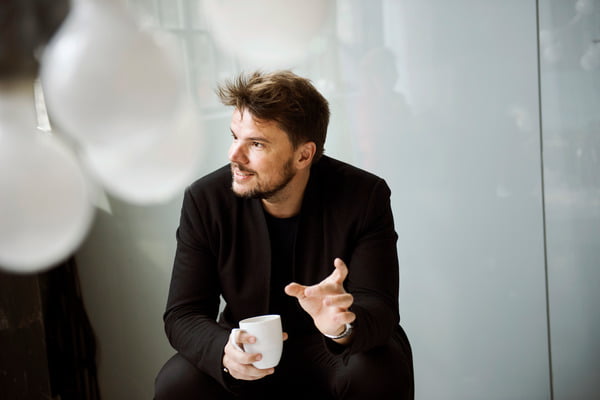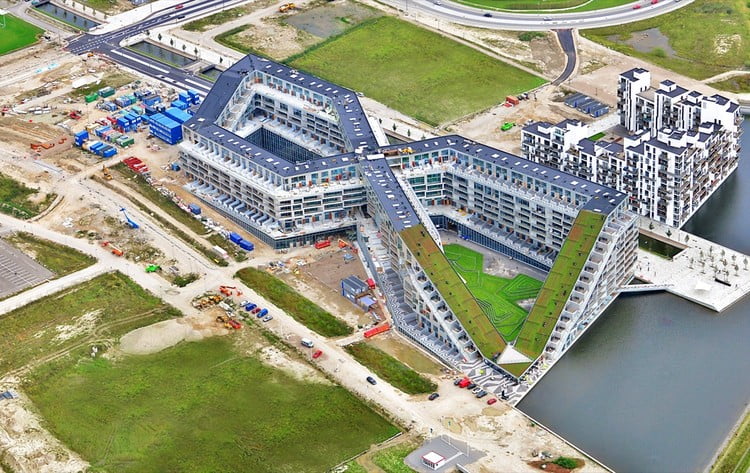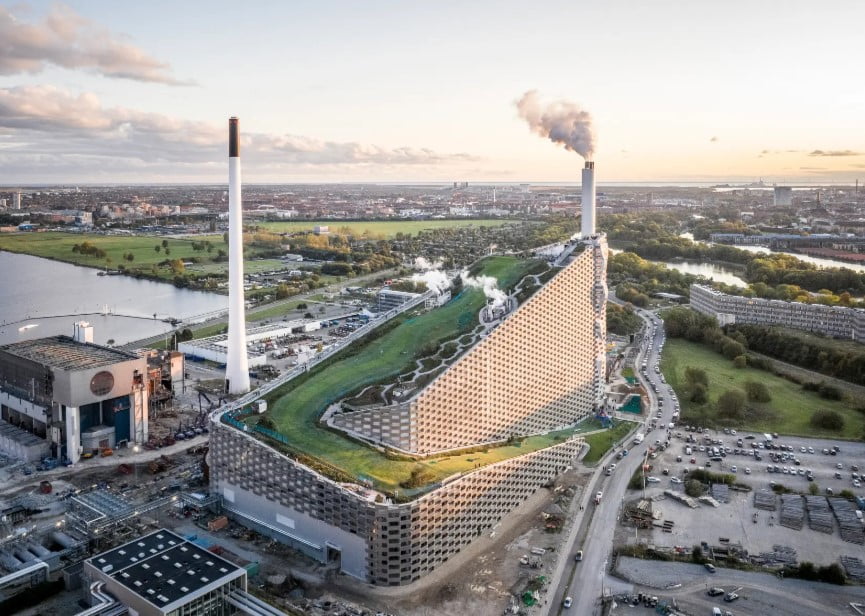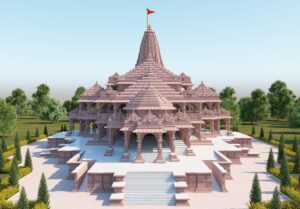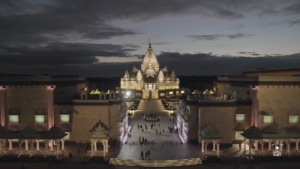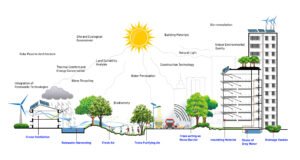Bjarke Ingels is a famous Danish architect who passionately intertwines his buildings with the people, creating a magnetic connection through his visionary architecture. He is the founder and creative director of the architectural firm BIG (Bjarke Ingels Group). Before starting his own firm, he worked at OMA (Office of Metropolitan Architecture) and co-founded PLOT Architects with Julien De Smedt. [1] He defines architecture as the art and science that can ensure that our buildings and cities fit with the way we want to live our lives. By carefully analyzing the culture and climate, we can understand the ever-changing patterns of contemporary life. His work emphasizes sustainability, community engagement, and a holistic approach to urban living.
He received a position as an ambassador for the EU’s New European Bauhaus in 2021. The AIA named him an Honorary Fellow in 2020, the RIBA in 2015, and the RAIC in 2014. He has won numerous architectural competitions and awards in his lifetime and was also named “Innovator of the Year” for his architecture by The Wall Street Journal in 2011. Time Magazine in 2016 named him one of the “100 Most Influential People” in the world. [1]
Apart from architecture, he is the author of two books named HOT TO COLD: An Odyssey of Architectural Adaption and Yes Is More: An Archicomic on Architectural. [4] He was also profiled in the first season of the Netflix docu-series Abstract: The Art of Design and My Playground, another documentary film. [6]
What do you think about him? Why is he becoming the modern face of architecture around the world? What influences him? If you’d like this type of blog, then share it with your friends and tell us which topic you want to read next from architecture. Comment below…
Early Life
Bjarke Bundgaard Ingels was born on 2 October, 1974 in the capital city of Denmark, Copenhagen. His father is an engineer, and his mother is a dentist. During his young days, he loved to draw and wanted to be a cartoonist, but his parents advised him to study the art of design. They enrolled him in architecture school at the Royal Danish Academy of Fine Arts in 1993, believing it would help him improve his drawing abilities. Immediately after joining there he developed an interest in architecture. Later, he continued his studies from Escola Tecnica Superior d’Arquitectura de Barcelona and returned to Copenhagen to receive his diploma in 1999. There as a first-year student, he set up his practice and won his first competition with a few friends. [4] [6]
From 1998 to 2001, he worked at the OMA (Office of Metropolitan Architects). It is a world-famous architectural firm that is led by Rem Koolhaas. Bjarke worked on several projects, most important the Seattle Central Library, which pictured a unique design of a library in the 21st century. The building went on to win numerous architecture awards and establish OMA as an architectural firm that can deliver larger projects. [5] In 2001, he left OMA to start his own firm and returned to Copenhagen. With his OMA colleague Julien de Smedt, he started his own architectural firm, PLOT.
With his ongoing architectural practice, he has also taught at Harvard University, Yale University, Columbia University, and Rice University as a visiting professor. He is also an honored professor at the Royal Academy of Arts, School of Architecture in Copenhagen. Alongside this, he is also a frequent speaker and holds lectures in exhibitions or venues like TED Talk, WIRED, AMCHAM, 10 Downing Street, the World Economic Forum, and many others. [1]
Recognition
PLOT was the big breakthrough for Bjarke Ingels; it brought national and international attention with its innovative designs. A major achievement for PLOT was the award-winning design of VM Houses in Orestad, Copenhagen, in 2005. The design and concept of these houses were inspired by Le Corbusier’s Unite d’Habitation. These residential blocks were designed in the shape of the English letters V and M (as seen from the sky). M house, which had 95 units finished construction in 2004, and V house, which had 114 units finished construction in 2005. The best part of the design was that it placed a strong emphasis on daylight, privacy, and views. All the apartments in these buildings have a diagonal view of the surrounding fields, and the corridors are short and bright. For this marvelous design, they won the Forum AID Award in 2006. [4]
At the end of 2005, both architects, Bjarke Ingels and Julien De Smedt, decided to close down PLOT, exactly after five years of fruitful collaboration. Both went on to open two new architecture firms: JDS Architects and BIG (Bjarke Ingles Group) in 2006. [1]
Achievements
He started BIG with his second housing project, Mountain Dwellings in Orestad, Copenhagen, on the VM Houses site. This project was the expansion of VM houses. The most interesting part of this project was that all the apartments in this complex have their own private rooftop gardens, where they can hang out and have quality time. This project finished construction in 2008 and received the World Architecture Festival Housing Award in 2008, the Forum AID Award in 2009, and the MIPIM Residential Award in 2009. This project stands as a beacon for architectural possibilities and stylish multifamily living.
His third housing project, 8 House, also achieved the same success. And received the Scandinavian Green Roof Award in 2010 and the World Architecture Festival Housing Award in 2011. The Huffington Post included it as one of the “10 Best Architecture Moments of 2001-2010.” [4]
BIG : Bjarke Ingels Group
Bjarke founded BIG in 2006 after disbanding PLOT in 2005. The BIG has grown globally over the last two decades, associated with works like landscaping, engineering, urban planning, architecture, interior design, product design, research, and development. The firm comprises over 700 family members, each with their own set of talents and ideas. They believe in addressing today’s difficulties by combining traditional ingredients such as living, leisure, working, parking, and shopping.
The journey of this firm began in Copenhagen, followed by offices in New York in 2010, London in 2010, Barcelona in 2019, and most recently in Shenzhen, Los Angeles, and Zurich. They have completed more than 60 buildings in 10 or more different countries. Currently, this group is working on projects in Europe, North America, Asia, and the Middle East. Bjarke Ingels Group has a total of 43 projects published on Arch Daily. [1]
Apart from BIG, Bjarke also co-founded the KiBiSi design agency in 2009 and Nabr (high-volume, integrated housing that is affordable and sustainable). [1] [2]
To read more about them, visit their websites.
Design Philosophy and Ideology
Bjarke Ingles coined the term “pragmatic utopianism,” a concept marrying ambitious creativity with practical solutions. His approach prioritizes the integration of functionality and form, ensuring each design not only captivates visually but also serves a purpose for its users. He creates a juxtaposition between striking design elements and local features. His buildings always have a surprising appearance while fitting right into the landscape and the terrain. He is a design activist whose design philosophy is “Hedonistic Sustainability.” He believes that environmentally conscious design should be an inherent part of architectural innovation and should be fun. Bjarke places a strong emphasis on human-centric design, fostering community connections evident in projects like the 8 House, Amager Resource Center, VM Houses, etc. [5]
How did he change the face of architecture in Copenhagen?
Bjarke Ingels has significantly changed the face of architecture in Copenhagen, Denmark, with his innovative and boundary-pushing designs. The majority of his work was done in Copenhagen and benefited a lot of the people around there. His projects not only stand as physical landmarks. But also serve as catalysts for a broader conversation about the role of architecture in enhancing the quality of urban living. Some of the examples of the building that he designed there are:
VM Houses and Mountain Dwelling: These residential complexes challenged traditional notions of housing, featuring bold, dynamic forms that deviated from conventional box-like structures. The success of these projects demonstrated Ingels’ ability to bring a fresh perspective to residential architecture.
The 8 House: A mixed-use development, redefined urban living in Copenhagen. The innovative form of the building as a figure-eight shape creates a diverse range of housing and commercial spaces, fostering a sense of community. This project challenged the conventional layout of urban structures, emphasizing the importance of thoughtful, community-oriented design.
To read a detailed case study on the 8-House Housing Complex, click here…
Superkilen Park: This project reflects Ingels’ commitment to cultural diversity and community engagement. The park incorporates elements from various global cultures, creating a vibrant and inclusive public space. This approach to designing public areas encourages social interaction and reflects a departure from traditional, homogeneous design concepts.
Amager Resource Center (ARC): With its dual function as a waste-to-energy plant and recreational facility, it showcases Ingels’ dedication to merging sustainability with adventure. The inclusion of a ski slope and climbing wall on the building’s exterior transforms an industrial facility into a dynamic and engaging structure, setting a precedent for the adaptive reuse of urban spaces.
Awards and Honors
He has won numerous awards in his lifetime and was also named “Innovator of the Year” for his architecture by The Wall Street Journal in 2011. Time Magazine in 2016 named him one of the “100 Most Influential People” in the world. Bjarke also received the Golden Lion at the 2004 Venice Biennale and the ULI Award for Excellence in 2009.
He received a position as an ambassador for the EU’s New European Bauhaus in 2021. The AIA named him an Honorary Fellow in 2020, the RIBA in 2015, and the RAIC in 2014.
His firm has also won numerous awards and been listed on various architecture platforms.
To read more about his awards and achievements, visit his website: Bjarke Ingels Group
Famous Projects
- VM Houses, Orestad, Copenhagen
- Mountain Dwellings, Orestad, Copenhagen
- 8 House, Orestad, Copenhagen
- Amager Resource Center, København, Copenhagen
- Two World Trade Center, New York, USA
- M/S Maritime Museum, Helsingør, Denmark
Contact Info.
Address: Kløverbladsgade 56, Valby, Denmark, 2500
Mobile: +45 72 21 72 27
Email: [email protected]
Website: http://www.big.dk/
Instagram: @bjarkeingels [3]
”For me, architecture is the means, not the end. It’s a means of making different life forms possible.”
”Yes is More’‘
Ar. Bjarke Ingels
Do you think good design can have a positive societal benefit? Do you see opportunity in areas of neglect? If you said yes, you are not alone, and Bjarke Ingels may just become your favorite architect. Comment below your thoughts…

